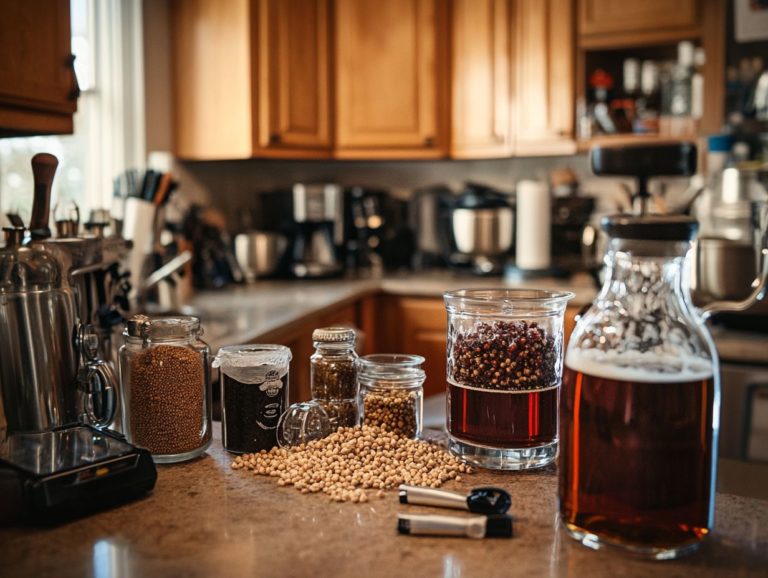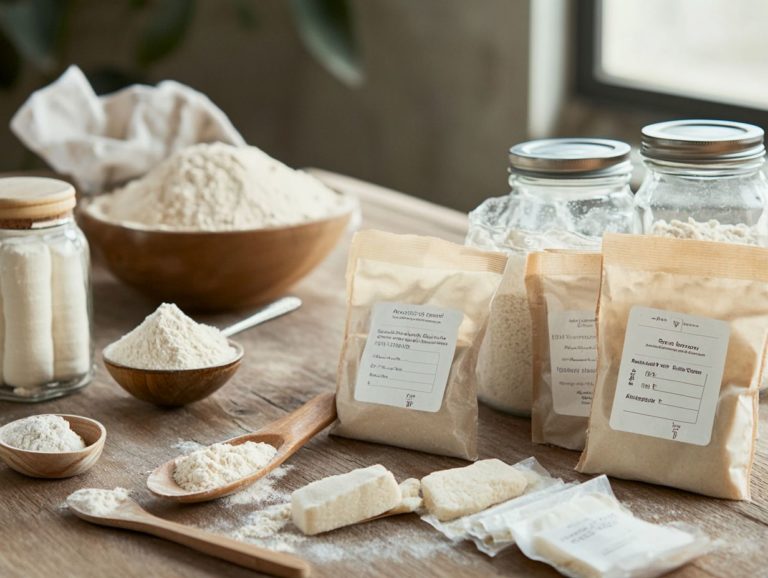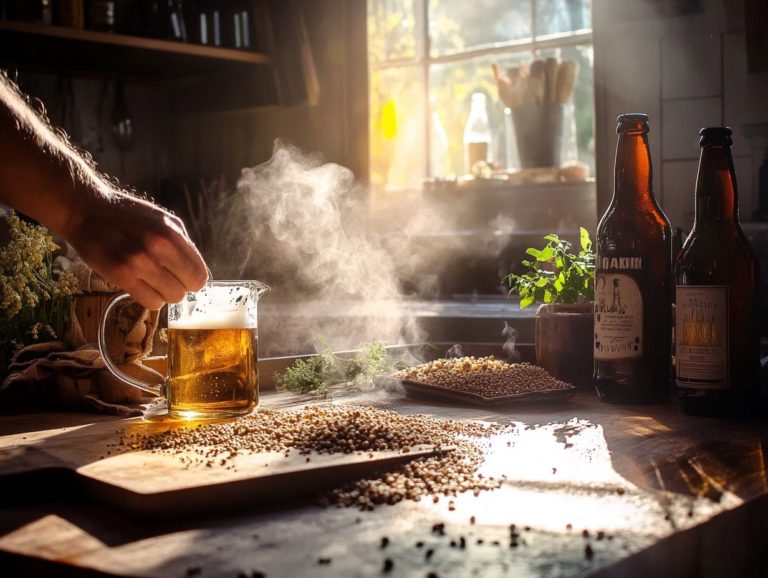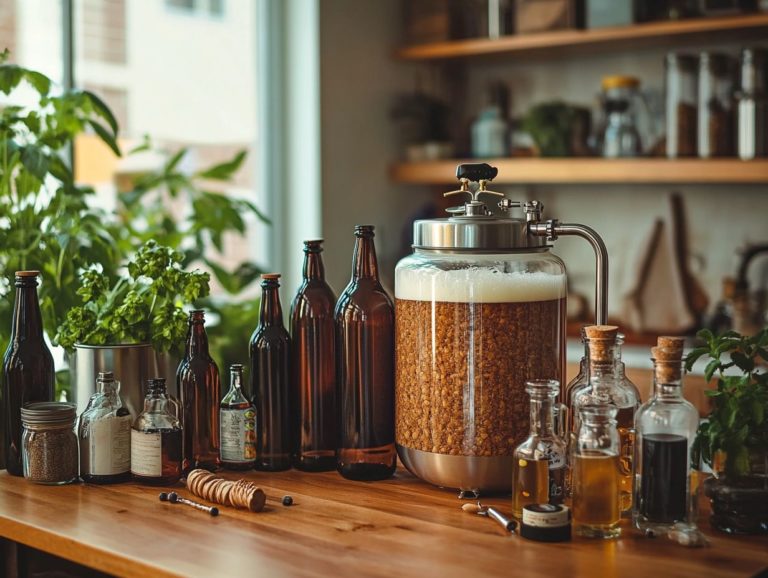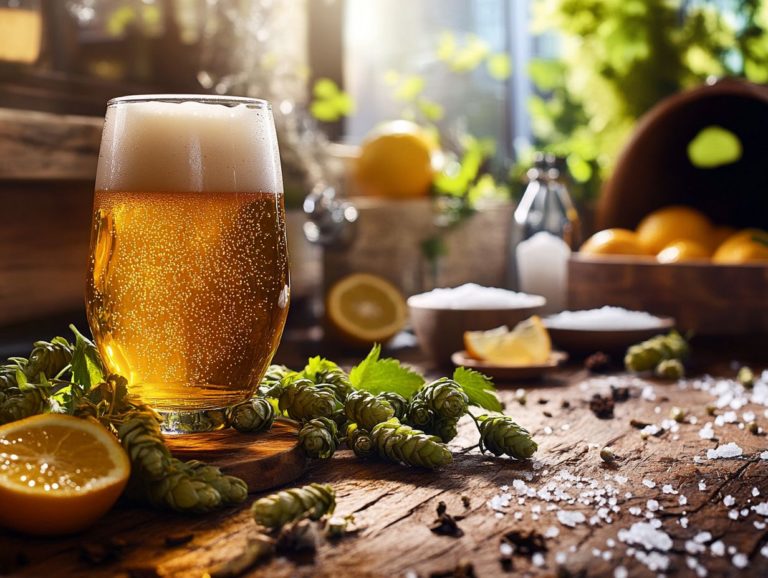What Is the Impact of Temperature on Brewing?
Contents
- The Art and Science of Brewing Coffee
- Key Takeaways:
- What Is Brewing?
- What Factors Affect Brewing?
- How Does Temperature Affect Brewing?
- What Is the Ideal Brewing Temperature?
- What Are the Different Temperature Variables in Brewing?
- Frequently Asked Questions
- What is the impact of temperature on brewing?
- How does temperature affect the flavor of beer?
- What is the ideal temperature for brewing beer?
- How does temperature impact the fermentation process?
- Can temperature fluctuations during brewing affect the final product?
- Are there any specific temperature requirements for different styles of beer?
The Art and Science of Brewing Coffee
Brewing coffee is not just a routine; it’s a delightful blend of art and science. By understanding the factors that contribute to the perfect cup, you can elevate your morning ritual to an experience worth savoring. This intricate process involves careful temperature control and understanding the chemical processes at play.
This exploration delves into the essential elements of brewing, such as water quality, grind size, and the all-important coffee-to-water ratio. The spotlight here is temperature, which plays a pivotal role in the brewing process, influencing everything from extraction rates to the nuanced flavors in your cup. Proper temperature control is crucial for optimal fermentation and achieving desirable flavors.
Whether you lean toward hot brews or the refreshing allure of cold coffee, you’ll uncover the ideal brewing temperatures and variables that can elevate your coffee experience to new heights. Dive in and discover the secrets to crafting your perfect cup, including an understanding of fermentation science and the different fermentation stages!
Key Takeaways:
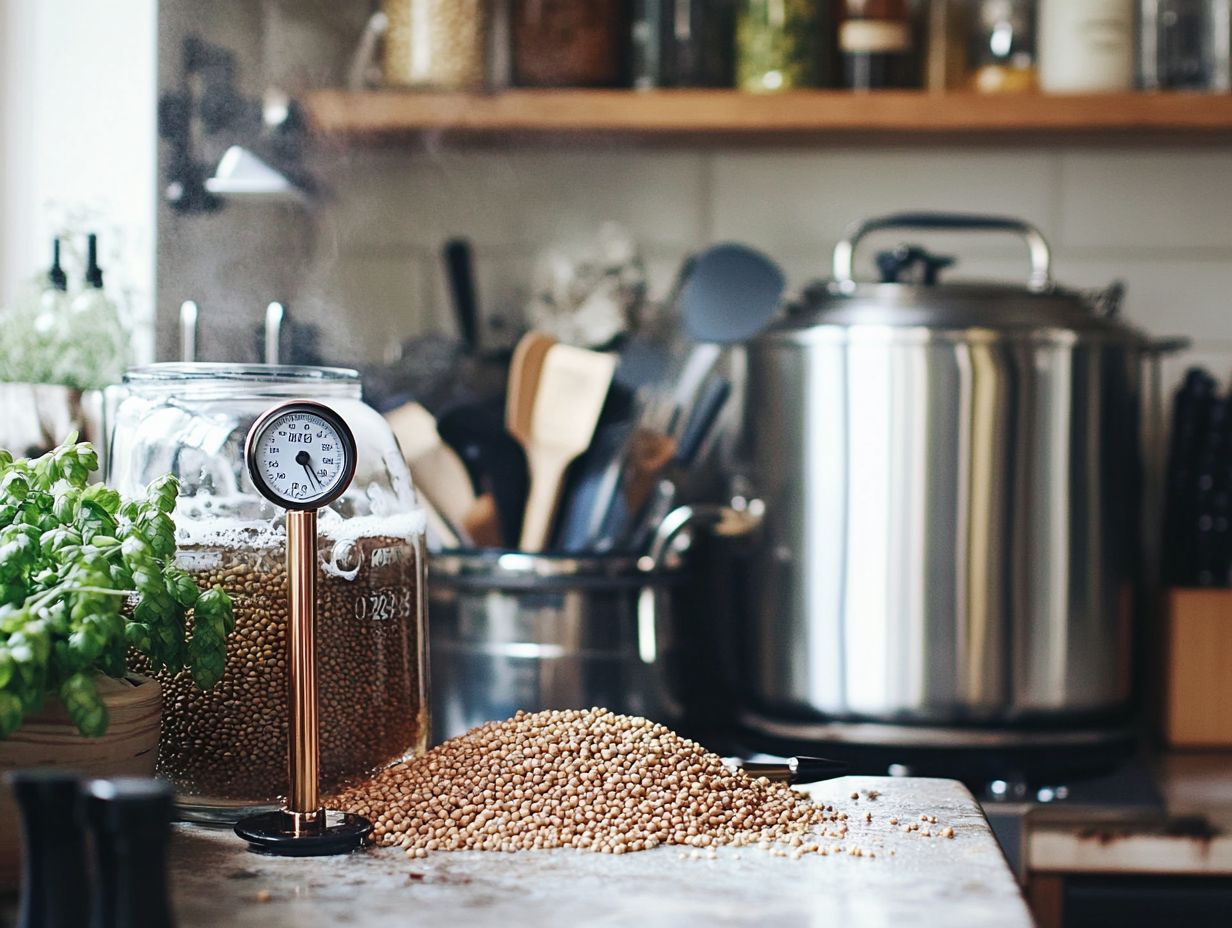
- The ideal brewing temperature greatly affects the extraction rate, flavor profile, and brewing time.
- Hot brewing methods require a higher temperature while cold brewing methods are best done at lower temperatures.
- Temperature variables, including water, room, and refrigeration temperatures, are essential for optimal brewing results, including sugar conversion and enzyme activity.
What Is Brewing?
Brewing encompasses a range of food products beyond beverages, including bread and yogurt. Each of these products relies on careful control of fermentation variables to achieve the desired quality and consistency.
Brewing is a skilled craft that involves crafting beverages like beer, wine, and even coffee through the delicate process of fermentation. At the heart of this process lies yeast, a crucial microorganism that transforms sugars into alcohol and carbon dioxide.
This metabolic dance not only produces the beloved alcoholic drinks you enjoy, but also enriches the flavors and aromas that characterize each unique beverage. The brewing journey consists of multiple stages, beginning with the careful selection of the ideal fermentation medium and extending to the precise control of temperature and diligent monitoring of fermentation outcomes.
To achieve a truly remarkable brew, you must grasp the nuances of fermentation dynamics and adeptly manage the conditions to create a high-quality product that delights the palate with its exceptional flavors. This includes monitoring fermentation reactions and understanding the impacts of different fermentation temperatures.
What Factors Affect Brewing?
Several critical factors influence your brewing process, from the quality of the water to the grind size of your ingredients. Each of these elements plays a vital role in fermentation efficiency, fermentation conditions, and the overall quality of your brew.
The way these factors interact determines fermentation outcomes and can significantly alter flavor profiles. This makes them essential considerations for anyone aspiring to achieve optimal fermentation.
Maintaining precise temperature control during fermentation is crucial. It impacts enzyme activity, yeast strains, and the fermentation rate, ultimately shaping the sensory quality of your final product. Whether you are practicing warm fermentation or cold fermentation, understanding the ideal temperature ranges is essential.
1. Water Quality
Water quality is paramount in brewing. It directly impacts the overall flavor and quality of your final product by influencing both the fermentation process and the performance of the yeast.
Properly balanced water enhances fermentation efficiency and helps in achieving the desired fermentation outcomes. The composition of your water is crucial; different minerals like calcium, magnesium, and sulfates not only determine hardness levels but also shape the distinctive characteristics of your brew.
For example, a higher calcium content can enhance yeast flocculation and attenuation, resulting in a more efficient fermentation process. On the flip side, pH levels significantly affect flavor extraction and the color from the grains, with an optimal range typically falling between 5.2 and 5.6 during mashing.
Water quality impacts the fermentation medium and ultimately the stability and consistency of your brew. Striking this precise balance is essential for meeting the brewing standards that set exceptional craft beers apart.
It also influences the aroma, mouthfeel, and stability of your final beverage. Ensuring that each sip is truly memorable is the goal.
2. Grind Size
The grind size of your coffee or malt plays a crucial role in the brewing process. It directly influences the extraction dynamics and fermentation reactions.
When you opt for a finer grind, you increase the surface area, which accelerates the extraction of flavors. This can enhance the sweetness and acidity of your brew, but be cautious too fine of a grind may lead to over-extraction and introduce undesirable bitterness into your cup.
Conversely, choosing a coarser grind slows down the extraction, resulting in a smoother and more balanced beverage that highlights the body while sidestepping any harsh notes, particularly in brewing methods like French press or cold brew.
Your choice of grind size also carries significant weight in determining fermentation characteristics. Various brewing techniques whether you re making espresso, drip coffee, or pour-over require specific particle sizes to ensure optimal extraction and a harmonious flavor profile.
3. Coffee-to-Water Ratio
Get the coffee-to-water ratio right, and you’ll unlock the perfect brew every time! This ratio is essential in crafting the perfect brew, playing a pivotal role in the extraction of flavors and aromas.
By meticulously adjusting this ratio, you can unlock a wide array of sensory experiences, from the bold bitterness of an over-extracted cup to the nuanced sweetness of a perfectly balanced brew.
If your ratio leans too heavily toward coffee, you risk creating a drink that overwhelms the palate, drowning out the subtle notes and resulting in an unbalanced experience.
On the other hand, a lighter mix can yield a brew that lacks body, causing the essential characteristics of the beans to become faint or even unrecognizable. Mastering this delicate balance is crucial for meeting brewing standards.
Achieving the harmonious extraction dynamics that elevate each cup to extraordinary heights requires practice and attention.
4. Brewing Method
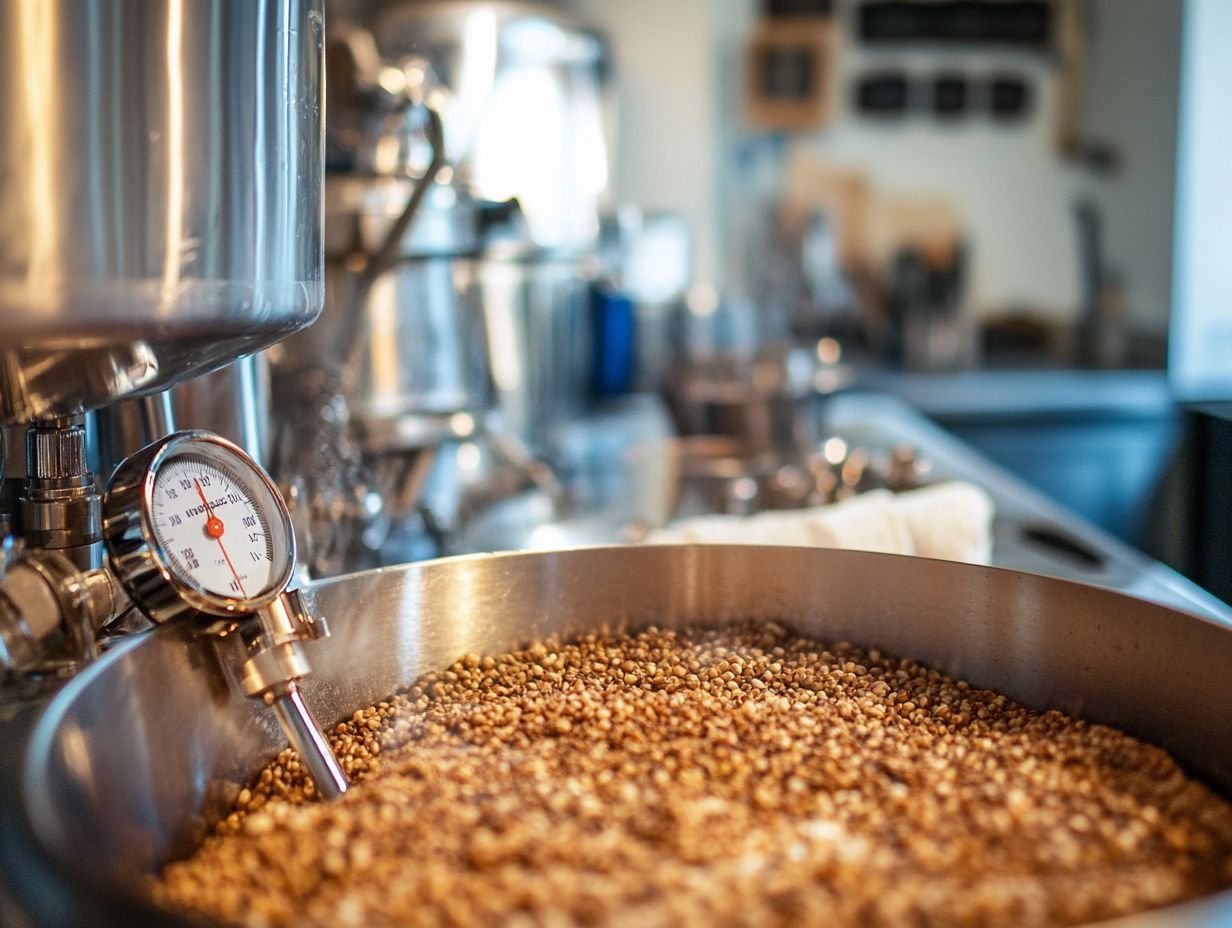
The brewing method you choose plays a pivotal role in shaping the final product. Various techniques employ different fermentation methods that significantly influence the brewing process and fermentation outcomes.
Take traditional methods like open fermentation, for example. They invite wild yeast to contribute, resulting in unique flavors and delightful complexities that commercial yeasts simply can t replicate.
On the other hand, controlled fermentation methods, such as closed fermentation, offer a more predictable outcome. These techniques often emphasize the malt and hop profiles, ensuring consistency in flavor that can be quite satisfying.
Understanding these methods is part of mastering fermentation science. Techniques like kettle souring can introduce tart notes that beautifully contrast with the sweetness of the malt perfect for those who crave a more dynamic taste experience.
Each method not only enhances the brewing quality but also leads to distinct sensory experiences in the final beverage. Experimenting with these methods can open up new dimensions in your brewing journey.
How Does Temperature Affect Brewing?
Temperature is paramount in the brewing process, as it directly impacts how yeast works during fermentation and the dynamics of fermentation. Achieving optimal fermentation conditions hinges on your ability to manage this critical variable. The fermentation temperature influences enzyme activity, fermentation rates, and the production of by-products, all of which play a significant role in shaping the flavor profile and overall quality of your brewed beverage. Different fermentation temperature ranges can lead to various sensory qualities in the final product.
By maintaining the ideal temperature range throughout the brewing journey, you can cultivate desirable flavors and enhance fermentation efficiency, highlighting the essential nature of temperature control in this art.
1. Extraction Rate
The extraction rate in brewing is significantly impacted by temperature. Higher temperatures typically prompt a more intense extraction of flavors and compounds from your ingredients, affecting the efficiency of the fermentation process and ultimately the brewing quality. Lower temperatures result in a gentler extraction that brings forth a milder flavor profile, allowing different notes to shine through. This careful interplay between heat and extraction becomes essential as you explore various brewing techniques, whether you’re preparing espresso, pouring over, or looking into cold brewing.
Each method responds uniquely to temperature tweaks, inviting you to experiment and refine your approach. As an espresso enthusiast, you might gravitate towards higher temperatures to amplify that rich, bold flavor. Meanwhile, if cold brew is your choice, using cooler water will yield optimal results, producing a smoother, less acidic extract that beautifully highlights those subtle nuances. This balance of brew temperature is crucial in achieving the perfect extraction dynamics.
2. Flavor Profile
The flavor profile of your brewed beverages is intricately tied to the temperature during the brewing process, as it significantly influences the balance of flavors extracted from the ingredients. When you brew at lower temperatures, you might discover a milder flavor with more subtle notes, allowing the intricate nuances of each ingredient to truly shine. Higher temperatures can accelerate the extraction process, leading to a stronger, more intense flavor profile that occasionally overshadows the finer details.
This dynamic interplay becomes particularly evident in fermentation characteristics, as yeast and other microorganisms respond differently depending on the temperature. This reaction influences not only flavor but also aroma and overall mouthfeel. Proper fermentation monitoring is essential to achieving the desired results.
Achieving optimal brewing quality depends on your understanding of these temperature ranges and how flavors are extracted, enabling you to create beverages that are not only rich in flavor but also harmonious, showcasing the unique characteristics inherent in each ingredient you use.
3. Brewing Time
Brewing time is a pivotal factor that works hand-in-hand with temperature control to shape the final flavor and quality of your beverage. You’ll find that longer brewing times can lead to either over-extraction or under-extraction, all depending on the temperature you choose. This interplay between these variables significantly impacts the balance of flavors and the aromatic profile of your brew, which is crucial for achieving desirable flavors.
Higher temperatures tend to extract flavors more rapidly, resulting in a strong taste, but beware if you extend the brewing time, you might end up with an unwelcome bitterness. On the flip side, lower brew temperatures usually require a longer brewing period to achieve a rich, full-bodied cup; yet if you’re not careful, you could end up with a watery brew if the time drags on too long.
By grasping these dynamics, you can fine-tune your brewing process, ensuring that the desired characteristics of your beverage shine through. This ultimately leads to a more enjoyable and satisfying experience.
In conclusion, understanding how temperature influences brewing is essential for any enthusiast aiming to enhance their beverage-making skills. Experimenting with temperature and brewing techniques can yield delicious results and elevate your brewing journey!
What Is the Ideal Brewing Temperature?
Unlock the secrets to perfect brewing by mastering your temperature control!
Hot Brewing Techniques
Identifying the ideal brewing temperature is crucial for elevating the flavor and quality of your beverages, as each brewing method necessitates specific temperature ranges to achieve optimal results and efficiency in sugar conversion.
For hot brewing techniques, such as traditional coffee brewing, maintaining a temperature between 195 F and 205 F is ideal for extracting delightful flavors while avoiding the pitfalls of over-extraction and bitterness, achieving optimal fermentation outcomes.
For those who favor hot brewing methods, it’s essential to maintain an ideal temperature between 195 F and 205 F. This range allows for optimal flavor extraction and significantly enhances the overall quality of your brewed beverage.
This temperature is critical because it directly affects how well the coffee s flavors blend into the water, enabling the release of the essential oils and flavors that create the drink’s unique character.
If you brew at a temperature that s too low, you risk under-extracting and compromising the metabolic process, which can lead to a flat, sour taste that lacks depth.
Exceeding the upper limit can lead to over-extraction, where undesirable bitter flavors take center stage, overshadowing the nuanced profiles that true connoisseurs appreciate, affecting overall sensory quality.
Thus, grasping and controlling the brewing temperature is vital for anyone who truly values the art of a well-crafted beverage and optimal fermentation.
Cold Brewing Techniques
Regarding cold brewing methods, you ll discover that the ideal temperature hovers between 60 F and 70 F. This sweet spot allows for a slow extraction process that delivers a truly distinct flavor profile.
In this moderate temperature environment, the coffee s natural oils and flavors are released gradually, resulting in a smoother, less acidic beverage compared to traditional brewing techniques.
As you immerse the coffee grounds in water for an extended period typically between 12 to 24 hours you ll enhance the extraction of those subtle flavor notes.
This method brings out the sweetness and floral notes in the coffee, making your final sip not only refreshing but also rich and complex. This interaction also aids in optimal fermentation efficiency, yielding a unique flavor profile.
Coffee enthusiasts often rave about how these temperature dynamics contribute to a unique tasting experience, truly setting cold brew apart in the vast world of coffee beverages.
What Are the Different Temperature Variables in Brewing?
Understanding the various temperature variables in brewing is essential for optimizing the fermentation process and crafting exceptional beverages. Key variables you ll want to pay attention to include water temperature, which plays a pivotal role in extraction and fermentation rates; room temperature, which can influence yeast activity and fermentation dynamics; and refrigeration temperature, crucial for cold brewing and the proper storage of ingredients.
Each stage of the fermentation process requires meticulous monitoring of these variables to ensure the best fermentation outcomes.
Each of these temperature parameters serves a specific purpose in the brewing process, and mastering their control can significantly enhance fermentation efficiency and refine the flavor profiles of your final product.
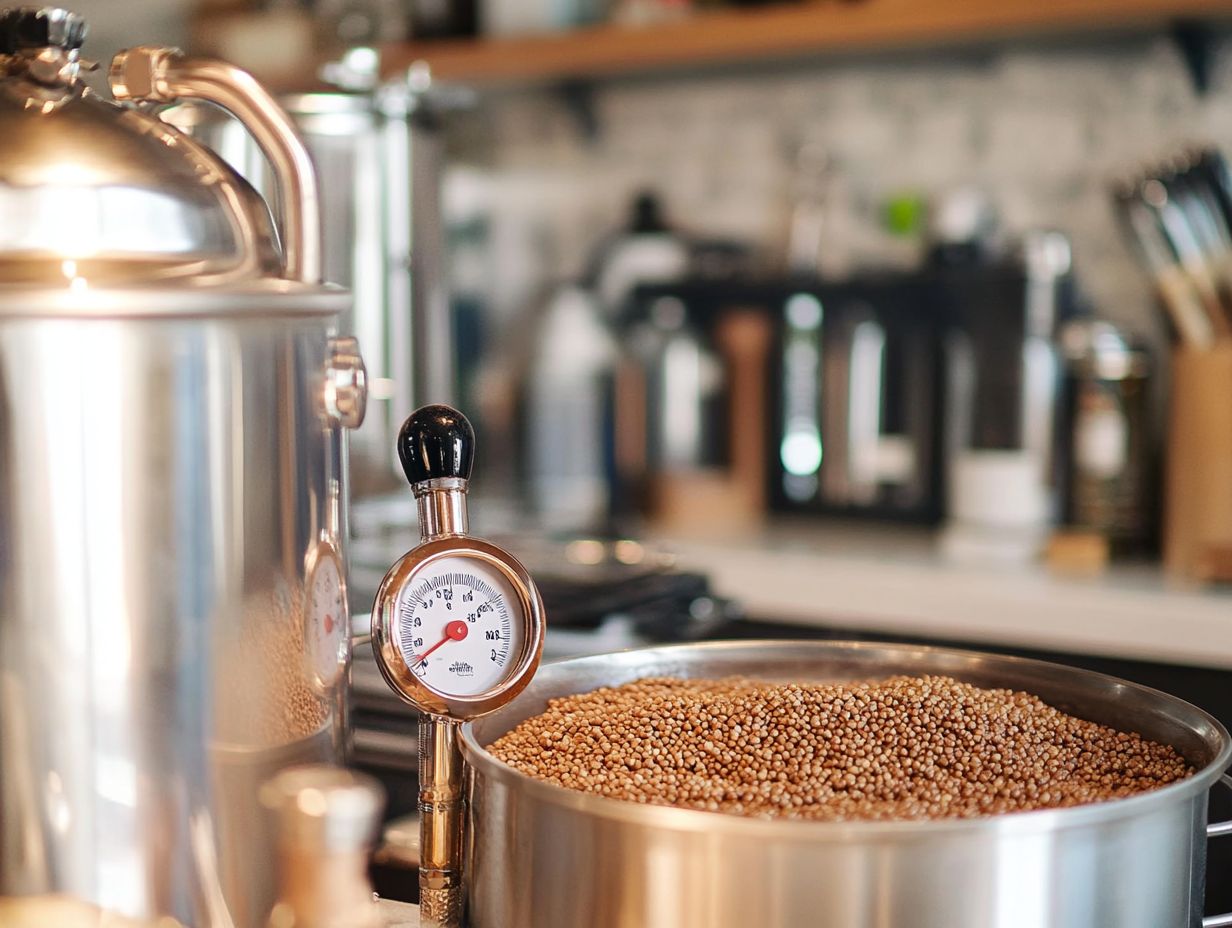
1. Water Temperature
Water temperature is an essential element in the brewing process. It directly influences the extraction of flavors and compounds.
When you brew, varying water temperatures can dramatically affect extraction rates and enzyme activity. Warmer water helps dissolve sugars and other vital compounds from the grains. This interaction is crucial for fermentation efficiency, as the yeast relies on these extracted elements for optimal growth activities.
If the water temperature is too high, you may encounter undesirable flavors or a drop in yeast performance, compromising your final product’s quality. Cooler temperatures slow down extraction and fermentation reactions, resulting in a more muted flavor profile.
Getting the temperature right is crucial for brewing success! It is vital for anyone looking to create a balanced and flavorful beverage with optimal fermentation characteristics.
2. Room Temperature
Room temperature plays a pivotal role in brewing, especially regarding yeast activity and fermentation dynamics. Maintaining an ideal room temperature is key for a successful metabolic process during fermentation.
In a warmer environment, yeast becomes more active, leading to quicker fermentation cycles. This speed can increase the production of esters and phenols essential compounds that shape the aroma and taste of your final brew. However, maintaining dissolved oxygen at optimal levels is crucial for robust yeast activity.
Cooler temperatures slow down fermentation, allowing for a more deliberate flavor development over time. This balance of temperature governs the fermentation rate and significantly influences the overall flavor profile and complexity of your beverage, crafting a unique experience for every enthusiast who savors it. This is especially important in producing food products like beer, wine, bread, and yogurt.
3. Refrigeration Temperature
Refrigeration temperature is crucial in your brewing journey, especially for cold brewing methods, where lower temperatures enhance a smoother extraction process.
By maintaining the right refrigeration temperature, you enhance extraction efficiency and play a significant role in shaping the final flavor profiles of your beverage. The cool environment in cold brewing minimizes the extraction of bitter compounds while elevating the natural sweetness and complex flavors of your chosen ingredients. This method is integral for achieving the best fermentation outcomes.
The result? A drink that is refreshingly crisp and aromatic, a true delight for the senses that meets the highest brewing standards.
Consistent refrigeration during storage is key to ensuring that the flavor remains stable over time, warding off unwanted changes that could detract from the overall quality. This meticulous temperature management is essential for crafting exceptional cold brews that truly stand out in taste and character, enhancing the sensory quality of the beverage.
Frequently Asked Questions
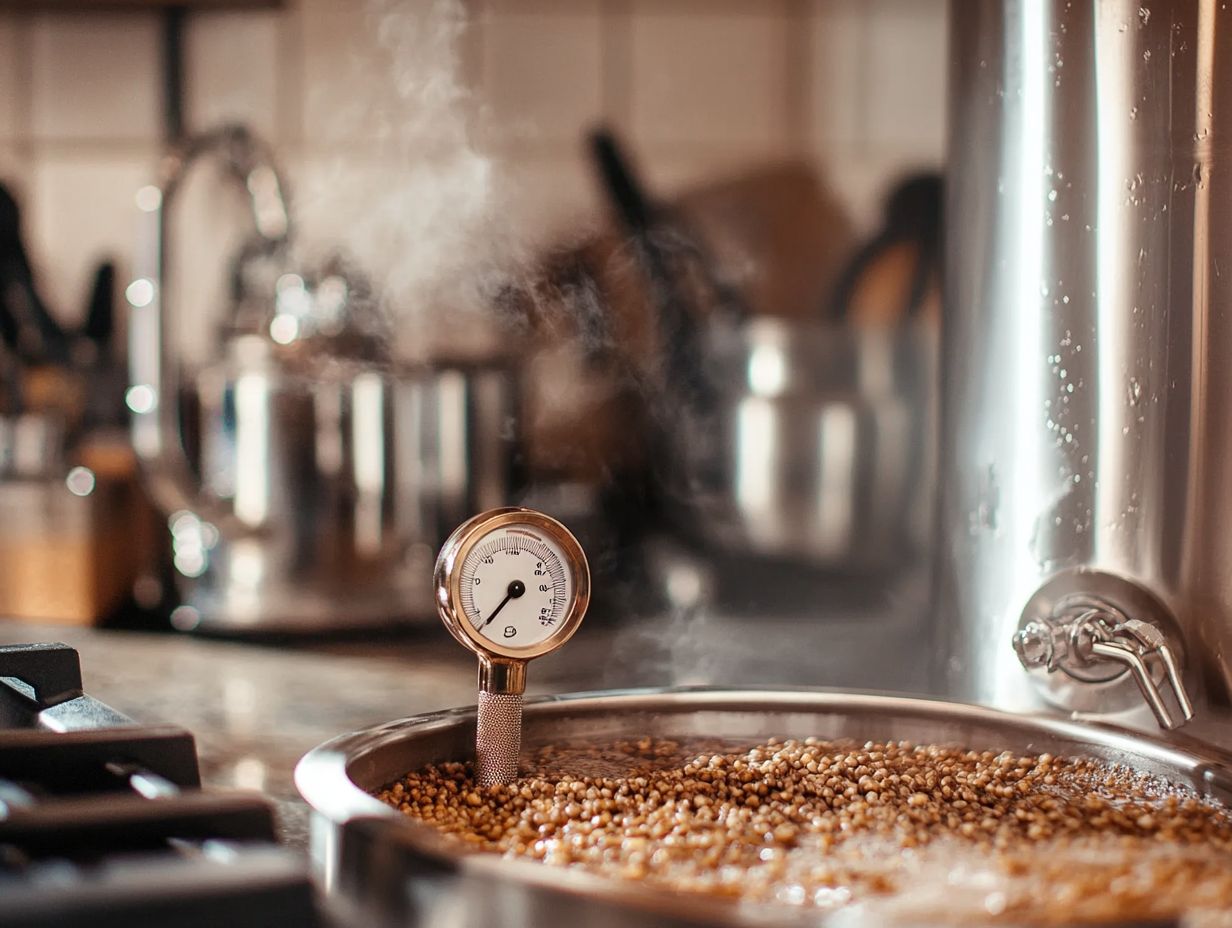
What is the impact of temperature on brewing?
The temperature during the brewing process plays a crucial role in determining the final taste, aroma, and quality of the beer.
How does temperature affect the flavor of beer?
Higher temperatures can lead to more bitter flavors, while lower temperatures can result in a smoother, less bitter taste in beer.
What is the ideal temperature for brewing beer?
The ideal temperature for brewing beer is typically between 65-75 F, depending on the type of beer you are brewing.
How does temperature impact the fermentation process?
Temperature significantly affects fermentation, impacting yeast activity and the production of certain flavors and aromas in the beer. Effective temperature control during fermentation stages is crucial for achieving optimal conditions and outcomes.
Can temperature fluctuations during brewing affect the final product?
Yes, temperature fluctuations during brewing can result in inconsistent and potentially off-flavored beer.
Are there any specific temperature requirements for different styles of beer?
Temperature Ranges for Brewing Ales and Lagers
Yes, different styles of beer require specific temperature ranges for the best brewing results. Lagers thrive in colder temperatures, while ales perform better in warmer conditions.
Getting the mash and fermentation temperatures just right is crucial for great beer. This attention to detail will lead to the best fermentation outcomes and flavor profiles.

